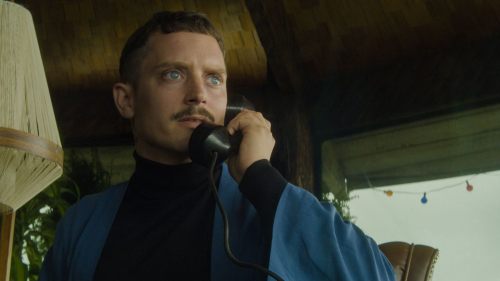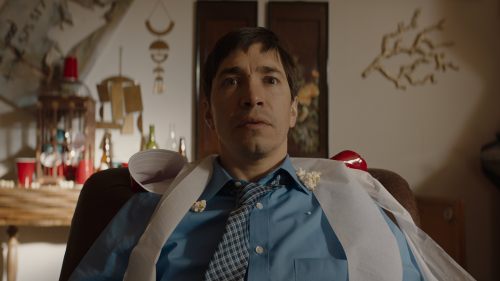Jack Henry Robbins Talks Recapturing the ’80s With VHYES
VHYes is about to hit a whole bunch of Drafthouses as a Fantastic Fest Presents title. Get your tickets here!
If you’re old enough to be a child of the videocassette era, Jack Henry Robbins’ VHYes will strike a deep chord of recognition. Even if you’re not, you can still respond to the movie’s themes while being mightily amused by its dead-on parodies of ’80s-era TV and video fare, and impressed by the way Robbins weds these segments to a perceptive study of a boy coming of age in 1987.
“I think it’s something we all can relate to: Escaping into our devices, whether it’s now or in the ’80s,” Robbins says. “The premise of the movie, in a sentence, is that a 12-year-old boy records over his parents’ wedding tape the same weekend their marriage is falling apart.”
Ralph (Mason McNulty) starts off training the camcorder he receives for Christmas on himself, goofing off alone and with his best friend Josh (Rahm Braslaw). When he learns he can plug into and record directly off the TV, their antics are intercut with bits of everything from a Dick Pierre porno flick called Hot Winter to the bizarre sitcom Ten of the Same (about a scientist who clones his dead son ten times—three of them turning out with alternate ethnicities) to an Antiques Roadshow-type program that takes an unexpectedly personal turn to Painting With Joan, whose host’s activities go in alarmingly bizarre directions. And throughout it all, Ralph captures brief, surreptitious clues to his parents’ disintegrating relationship, as when he and Josh sneak into a theater to see Zombie Alien Hell 4 and spy Ralph’s dad sitting down with an unfamiliar woman.
The son of Tim Robbins and Susan Sarandon (both of whom have cameos in VHYes), Robbins didn’t draw from his own family experience for his movie, but did do a lot of experimenting with video in his youth. “I experienced the collage that can come out of recording onto tape: recording shows, recording your life, and the weird result produced by that. I remember recording wrestling a lot; I’d tape some match and then show me and my brother recreating it. Sometimes I would record a movie, and then stop the movie and finish the line. What I find fascinating in retrospect about VHS is how it was the first time we had such a cheap medium to be able to film our lives and record content. Before that, it was Super-8, but VHS was the first time it was quite accessible.”
He adds that he never recorded over such an important cassette as Ralph does—“but my cinematographer, Nate Gold, actually has a family member who did record over a wedding tape. I think it was his brother who taped Die Hard over it or something like that, so that was pretty bad.”
Robbins first shot Hot Winter and Painting With Joan as individual shorts a few years back, and initially thought they could provide the basis for a Monty Python-esque sketch show. Then Oscilloscope Laboratories (which is releasing VHYes to theaters this Friday) saw them and provided funding to use them as the basis for a feature. “We pretty much had a month to make the script happen,” says Robbins, who wrote it with Nunzio Randazzo, “and the first draft had no through-line; it was just sketches, which was a problem. I think one of the most important things in comedy is, you need to have heart, and a reason for everything. So we came up with the idea of this kid who was going to take us through it all, and the element of his parents’ marriage falling apart.”
Among the new segments they came up with, one of the best is Ten of the Same, which perfectly captures the feel of the sci-fi/fantasy-tinged TV laffers of the period. “One of the things I love about that segment is that it’s written to be not funny on purpose, you know what I mean? We had to write it like a kooky, horrible idea for a television show where this guy clones 10 versions of his son, and three are obviously diversity hires. Ten of the Same is basically a really weird look at semi-funny sitcoms that got cancelled after one season.”
A number of familiar faces pop in and out of VHYes, including Kerri Kenney, who saw Hot Winter after it got booked into the 2017 Sundance Film Festival and was subsequently cast in Painting With Joan. That helped Robbins approach more talent for VHYes, including Mark Proksch and Charlyne Yi. “And Thomas Lennon actually donated to our Kickstarter,” Robbins reveals. “I was monitoring the page and saw that Thomas gave us this money, and I was like, ‘Holy shit! You think he’d actually do a part in our movie?’ And then once we got in touch with him, I asked him who he wanted to be partnered with, and he picked Courtney Pauroso, which was amazing. We got really lucky with the casting.”
That luck didn’t entirely continue when it came to putting VHYes before the cameras (utilizing only VHS and Betacam equipment). “After the first week, our production truck, with everything but the cameras on it, was stolen, and then gutted and destroyed. We were very lucky we had insurance, and that everyone rallied after that, but it was hard. We had an ultra-low budget; it was under $250,000, and we shot everything in about 16 days.” Some of the segments were filmed at his father’s Actors’ Gang Theater, and others at various locations in the Los Angeles area. “We shot the entire detective show, all of Ten of the Same, and all of the interviews for Blood Files: Witch of West Covina in the same day on a set in Anaheim or somewhere. And there’s a huge segment we did that’s not in the movie, except for about a second-long clip. It was another porno called Serf’s Up, about a surf competition but also about serfism and the one percent.”
That particular sociological satire may not have made it to the final cut, but there’s deeper meaning to many of the other comedic snippets Ralph assembles on his tape. Some of them speak to the darker concerns of the world in which he’s growing up: a folksy character named Kindly the Cowboy consoles a boy who’s been bullied, Hot Winter is a skin flick about global warming, and Witch of West Covina, in which a sorority girl’s magic trick inspires her sisters to burn her as a witch, reflects the “Satanic panic” that drove many to distraction in the ’80s.
“It’s about general fearmongering, with a twist,” Robbins says. “I think fear is something that has controlled us for a very long time. There’s that line in the movie: ‘Are you paranoid? If you’re not, you might be. News at 11,’ and then it goes into the home-security sketch. To me, there’s always been fear on television; people are always trying to scare you into buying shit.”
Robbins, on the other hand, hopes that VHYes’ viewers respond to his movie’s unique blend of oddness and emotion; so far, festival screenings have gone well and reviews have been positive. “The fact that people like it and are open to it makes me feel the world is a little weirder than I thought, which is great. I love the weird stuff, and this movie gets dark and funny and strange, and people have been really responding to it. I don’t want to just make movies that are funny, I want to make movies that say something, and I wanted VHYes to resonate and say something about who we are. So I’m glad Oscilloscope let me do it, and I’m so excited for more people to see it.”



